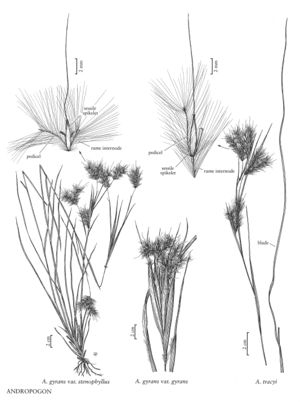familyPoaceae
subfamilyPoaceae subfam. Panicoideae
genusAndropogon
sectionAndropogon sect. Leptopogon
speciesAndropogon gyrans
Difference between revisions of "Andropogon gyrans var. gyrans"
Common names: Elliott's beardgrass
Synonyms: Andropogon campyloracheus
Treatment appears in FNA Volume 25. Treatment on page 657.
FNA>Volume Importer |
imported>Volume Importer |
||
| (2 intermediate revisions by the same user not shown) | |||
| Line 20: | Line 20: | ||
-->{{Treatment/Body | -->{{Treatment/Body | ||
| − | |distribution=Del.;D.C;W.Va.;Fla.;N.J.;Tex.;La.;Tenn.;N.C.;S.C.;Pa.;Va.;Ala.;Ark.;Ill.;Ga.;Ind.;Md.;Okla.;Ohio;Mo.;Miss.;Ky. | + | |distribution=Del.;D.C.;W.Va.;Fla.;N.J.;Tex.;La.;Tenn.;N.C.;S.C.;Pa.;Va.;Ala.;Ark.;Ill.;Ga.;Ind.;Md.;Okla.;Ohio;Mo.;Miss.;Ky. |
|discussion=<p><i>Andropogon gyrans </i>var.<i> gyrans</i> generally grows in dry, sandy soil of roadsides, embankments, fields, and pine or oak woods, occasionally in moister soil. Its range extends south from the United States to the Caribbean and Central America. Plants from Florida and Mississippi do not have inflated sheaths.</p> | |discussion=<p><i>Andropogon gyrans </i>var.<i> gyrans</i> generally grows in dry, sandy soil of roadsides, embankments, fields, and pine or oak woods, occasionally in moister soil. Its range extends south from the United States to the Caribbean and Central America. Plants from Florida and Mississippi do not have inflated sheaths.</p> | ||
|tables= | |tables= | ||
| Line 38: | Line 38: | ||
|illustrator=Linda A. Vorobik;Hana Pazdírková | |illustrator=Linda A. Vorobik;Hana Pazdírková | ||
|illustration copyright=Utah State University | |illustration copyright=Utah State University | ||
| − | |distribution=Del.;D.C;W.Va.;Fla.;N.J.;Tex.;La.;Tenn.;N.C.;S.C.;Pa.;Va.;Ala.;Ark.;Ill.;Ga.;Ind.;Md.;Okla.;Ohio;Mo.;Miss.;Ky. | + | |distribution=Del.;D.C.;W.Va.;Fla.;N.J.;Tex.;La.;Tenn.;N.C.;S.C.;Pa.;Va.;Ala.;Ark.;Ill.;Ga.;Ind.;Md.;Okla.;Ohio;Mo.;Miss.;Ky. |
|reference=None | |reference=None | ||
|publication title= | |publication title= | ||
|publication year= | |publication year= | ||
|special status= | |special status= | ||
| − | |source xml=https:// | + | |source xml=https://bitbucket.org/aafc-mbb/fna-data-curation/src/200273ad09963decb8fc72550212de541d86569d/coarse_grained_fna_xml/V25/V25_1585.xml |
|subfamily=Poaceae subfam. Panicoideae | |subfamily=Poaceae subfam. Panicoideae | ||
|tribe=Poaceae tribe Andropogoneae | |tribe=Poaceae tribe Andropogoneae | ||
Latest revision as of 18:57, 11 May 2021
Ligules 0.3-0.8(1.1) mm. Inflorescence units usually with 2-5 rames; rames usually concealed at maturity.
Distribution
Del., D.C., W.Va., Fla., N.J., Tex., La., Tenn., N.C., S.C., Pa., Va., Ala., Ark., Ill., Ga., Ind., Md., Okla., Ohio, Mo., Miss., Ky.
Discussion
Andropogon gyrans var. gyrans generally grows in dry, sandy soil of roadsides, embankments, fields, and pine or oak woods, occasionally in moister soil. Its range extends south from the United States to the Caribbean and Central America. Plants from Florida and Mississippi do not have inflated sheaths.
Selected References
None.
Lower Taxa
None.
